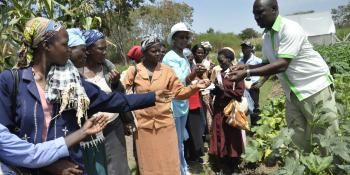How healthy is Tanzania's soil? New project takes a closer look

by Leigh Winowiecki
Land degradation is seen as one of the causes of low agricultural yields as well as loss of biodiversity. Increasingly, researchers are also linking land degradation to poverty. Looking at ecosystem and soil health, we see that there are many different drivers of land degradation, which vary across ecoregions and climatic zones. Identifying these drivers and developing improved management strategies are further compounded by the changes in climate. This complexity calls for an interdisciplinary approach that links the socio-economic factors affecting everyday life of rural farmers in East Africa with systematic assessments of soil and ecosystem health. This is especially relevant in order to develop appropriate climate change adaptation and mitigation strategies.
Therefore the CGIAR Research Program on Climate Change, Agriculture and Food Security (CCAFS), together with the Center for Tropical Agriculture (CIAT) in Colombia (CIAT-Soils Program based in Nairobi, Kenya), are together supporting a new project: “Playing out transformative adaptation in CCAFS benchmark sites in East Africa: When, where, how and with whom?”. This project aims to link assessments of soil and ecosystem health with the CCAFS Household survey data to identify key constraints and opportunities for adaptation strategies in four Benchmark sites in East Africa. Most recently, the biophysical field assessment was conducted in the northern Tanzania CCAFS Benchmark site, Lushoto, during the month of October!
This site is located within the Usambara Mountains of Tanzania, which is a landscape with steep slopes, various water sources and native forest fragments. There are also a variety of land uses, inlcuding: intensive smallholder vegetable production; smallholder maize, beans and cassava production; as well as patches of forest. Understanding these landscape-scale dynamics in such a diverse landscape requires a systematic survey of soil and land health.
In the current project, the Land Degradation Surveillance Framework (LDSF) was adapted to assess ecological and soil metrics relevant for climate change adaptation and mitigation strategies. A field training hosted by CIAT-TSBF Soils program and lead by Dr. Leigh Winowiecki was held in Karura forest in Kenya in September.
The biophysical field survey in Lushoto was carried out in October 2012. The field team was hosted by Selian Agricultural Research Institute in Arusha, the Lushoto District Agricultural Office, and the Tanzania Forestry Research Institute (TAFORI). The team collected soil samples, measured shrub and tree densities, observed the occurrence of visible erosion, recorded land-use history and basic farming practices, among other variables. The idea is to use the data from the survey to identify key biophysical constraints to land productivity and link this with the socio-economic survey to identify feasible opportunities for improved land management strategies. This is possible because the biophysical survey plots overlapped with the seven villages sampled for the CCAFS household survey.
Local farmers involved in the survey are excited to receive the information on the soil fertility status of the fields. They also expressed interest to see the results of the land health assessment. Farmers visited the field team during the survey and were interested to learn the methods employed for taking soil samples and measuring infiltration capacity.
Socio-economic survey data indicate that farmers employ a diversity of land management strategies in response to shifts in climate as well as perceived changes in land productivity. Preliminary data indicate that erosion prevalence is high, and most trees on the farms are introduced (non-native) species. More analysis will be completed once laboratory results for the soil samples are complete. Interdisciplinary analysis linking household data with the biophysical assessment will enable a comprehensive analysis aimed to better assess and develop potential climate change adaptation and mitigation strategies within the Lushoto benchmark site. Next month CIAT-DAPA scientists will visit the Lushoto site to conduct participatory farmer workshops and discuss preliminary results of crop suitability models!
Dr. Leigh Winowiecki is a Soil Scientist for the African Soil Information Service under Soils Research Area. She holds a PhD in Soil Science and Tropical Agroforestry


